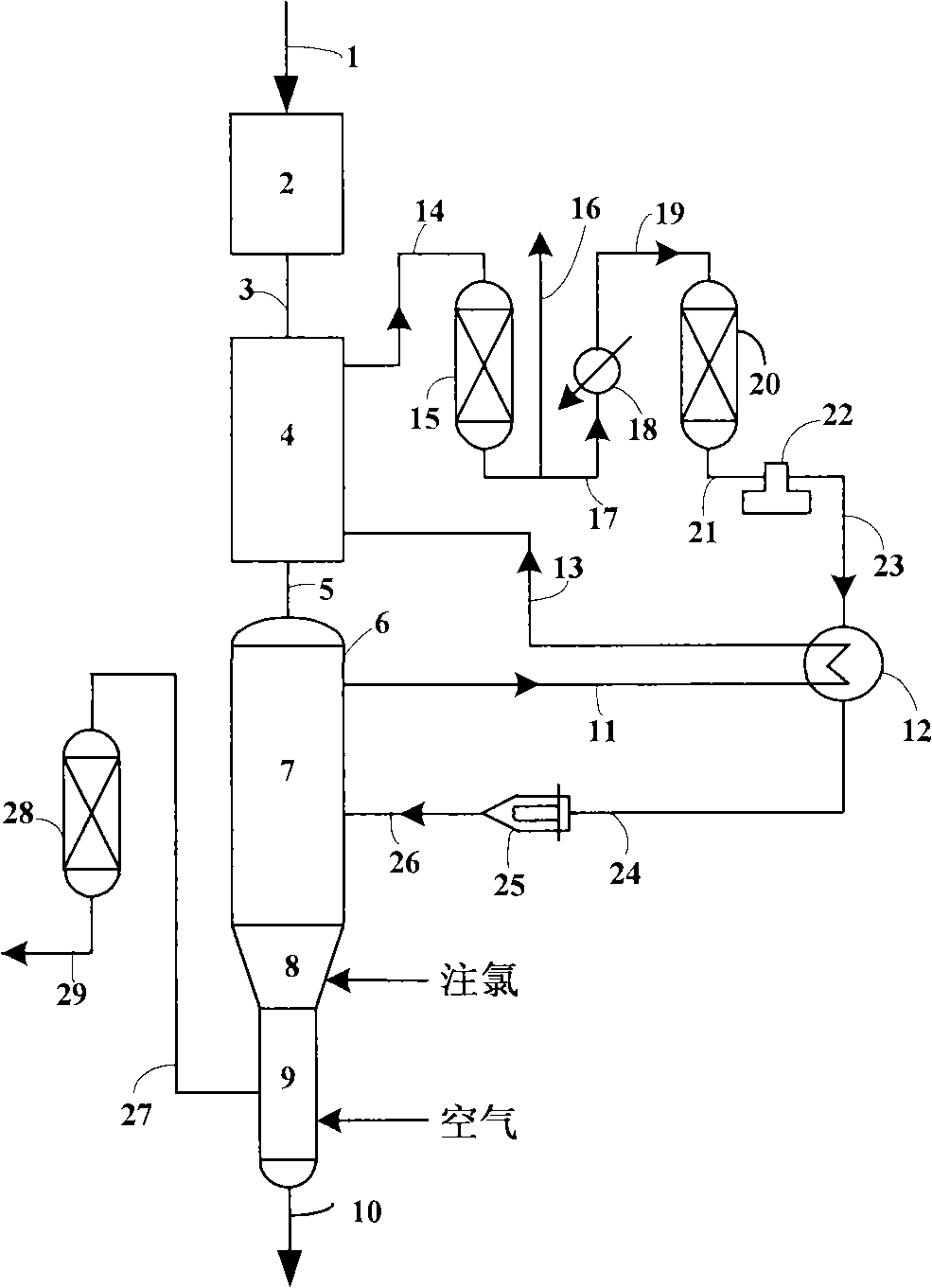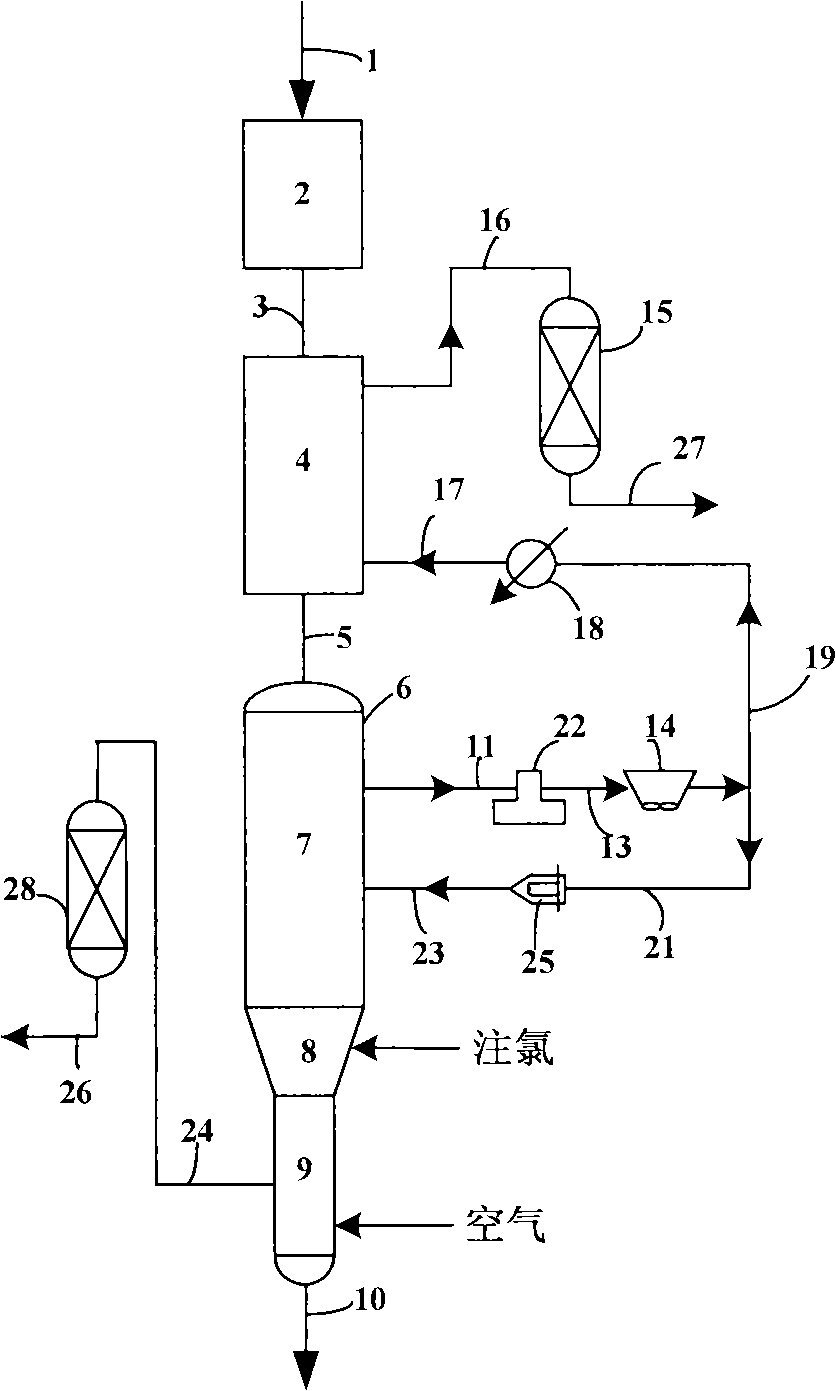Method for dechlorinating gas discharged from continuous reforming regenerator
A technology of exhaust gas and regenerator, which is applied in the field of removing chlorides in the exhaust gas of reforming regenerator by using the spent catalyst and dechlorination agent, which can solve the problems such as the decline of chlorine holding capacity, and achieve the reduction of operating costs and good dechlorination effect, not easy to muddy effect
- Summary
- Abstract
- Description
- Claims
- Application Information
AI Technical Summary
Problems solved by technology
Method used
Image
Examples
preparation example Construction
[0026] The preparation method of the solid dechlorination agent comprises mixing alkaline earth metal oxides or their precursors, alumina or its precursors, and bentonite as raw materials, then adding a pore-enlarging agent and mixing evenly, and extruding the strips at 450-700°C Roasting.
[0027] The alkaline earth metal oxide described in the above method is preferably calcium oxide, and the precursor of the alkaline earth metal oxide is preferably calcium hydroxide, calcium carbonate or calcium bicarbonate. The precursor of alumina is preferably pseudoboehmite or alumina sol.
[0028] The pore-enlarging agent is preferably methyl cellulose or ammonium bicarbonate, and the amount of the pore-enlarging agent added is 0.5-15% by mass of the total amount of raw materials, preferably 1.0-10% by mass.
[0029] In the preparation method of the dechlorination agent, after mixing the raw materials and adding the pore-enlarging agent, it is preferable to add the extrusion aid. The a...
example 1
[0039] Prepare the dechlorination agent used in the present invention.
[0040] Get 15 grams of pseudo-boehmite (aluminum oxide content is 70 mass %, the PURAL that Germany Sasol company produces SB), 2 grams of calcium-based bentonite (dry base solid content is 90 mass %, Henan Xinyang Daye Bentonite Co., Ltd.) and 80 grams of calcium hydroxide are mixed to make raw materials, add 2 grams of methylcellulose (Shandong Ruitai Chemical Co., Ltd. Production) and 2 gram of Squatia powder mix homogeneously, then add 15ml concentration and be that the nitric acid of 33 mass % and 45ml deionized water mix and knead evenly, extrusion molding, 120 ℃ of drying 2 hours, 650 ℃ of roasting 4 hours, make dechlorination agent A, its composition and physical properties are shown in Table 1, wherein the specific surface area and pore volume were measured by the low-temperature nitrogen adsorption method on a Micromeritics ASAP2400 analyzer, and its breakthrough chlorine capacity at different ...
example 2
[0042] The chlorine content in the circulating gas at the outlet of the regenerator is 3052ppm, and the water content is 13000ppm. The gas is at 260°C, 0.35MPa, and the volume space velocity is 1000h -1 Under the conditions of the fixed bed with a carbon content of 4.1% by mass and a specific surface area of 135m 2 / g of the waiting raw platinum-tin catalyst contact, which contains 0.28 mass % of Pt, 0.30 mass % of Sn, and the rest is an alumina carrier; the chlorine content discharged from the fixed bed after being adsorbed by the waiting raw catalyst is 285ppm exhaust gas, and then enters a Dechlorination tank equipped with dechlorination agent A, at 240°C, 0.35MPa, and volume space velocity of 1000h -1 Contact with the dechlorination agent A in it under certain conditions, the chlorine content of the gas after dechlorination is less than 0.5ppm, and the dechlorination agent A is not muddy.
PUM
 Login to View More
Login to View More Abstract
Description
Claims
Application Information
 Login to View More
Login to View More - R&D
- Intellectual Property
- Life Sciences
- Materials
- Tech Scout
- Unparalleled Data Quality
- Higher Quality Content
- 60% Fewer Hallucinations
Browse by: Latest US Patents, China's latest patents, Technical Efficacy Thesaurus, Application Domain, Technology Topic, Popular Technical Reports.
© 2025 PatSnap. All rights reserved.Legal|Privacy policy|Modern Slavery Act Transparency Statement|Sitemap|About US| Contact US: help@patsnap.com



